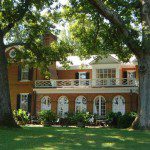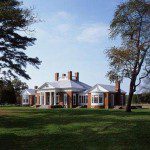Rhett Architects, Building on the Beauty of Virginia
By • March 13, 2013 0 1787

John Rhett moved from Houston, Texas, to Charlottesville, Va., in 1981. He had a double degree in architecture and fine arts from Rice University and, having worked in the world of corporate architecture, was searching for a back-to-basics approach to his life and work. Fate, however, was playing a larger role in his relocation to Charlottesville than he could ever have realized.
Rhett had already studied solar architecture in New Mexico in the 1970s, and had constructed some major projects with the surrounding Pueblo community. These projects combined elements of contemporary architectural innovation with ancient cultural building techniques, creating sustainable adobe structures that became a part of the land they were built upon. Shortly after moving to Charlottesville, Rhett started working for one of the city’s only modern architectural firms. Creating modern structures amidst Charlottesville’s lush forests and rolling, fertile landscapes, he found a synthesis between nature and structure that suited his contemporary architectural ideals and deep-rooted pursuits. It was here that Rhett saw a foundation for what would become his life’s work.
He began working for the renowned garden designer François Goffinet, who taught him a multidisciplinary approach of incorporating architecture into natural environments. “Goffinet would work with a team of architects, botanists, carpenters, and even historians of garden design,” says Rhett. “And his projects—parks, gardens, houses and corporate campuses—have such a harmony that resulted from this orchestration of disciplines. His spaces are like musical compositions of physical structures.”
Rhett began working on projects around the world, from Portugal, Oxfordshire, Bel Air and Carmel, to the San Juan Islands just north of Seattle. Each structure, he came to understand, was inextricably linked to its surrounding environment.
“It occurred to me,” he says, “that whether you are building adobe pueblos or Georgian mansions, the incorporation of the surrounding landscape and harmony with the character of the environment are core values that I had been unconsciously pursuing since day one.”
Meanwhile, Rhett had fallen in love with the character and environment of Charlottesville. “Between the history, the beauty, the innovation, and the shear lifestyle, there was something timeless about this place that drew me in and didn’t let me go. I think Thomas Jefferson got it right when he chose Charlottesville as the place to build his home at legacies.”
Jefferson became a strong influence on Rhett and his work, for Jefferson shared with him a fierce love for the land as well as notions on the historical responsibilities of architecture. Upon writing to the politician George Gilmer in 1787, Jefferson remarked: “I am as happy no where else and in no other society, and all my wishes end, where I hope my days will end, at Monticello.”
Rhett brings this philosophy into his work, designing and building country houses that are part of the land they are built upon, and drawing upon its surroundings to shape the gardens and parks he creates to suit them. “I’ve always loved natural surroundings. So, landscape design is a perfect and natural companion to the architecture.”
Building homes also allows Rhett to work with individuals to help others realize their dreams. Much of the satisfaction, he explains, comes from turning a shared vision into a reality. “I want to give my clients the tools to create the home they can only imagine, to take something from theory into reality. In the process, we both discover things. I had one client who at first did not have any confidence in her choices. And while we worked together, she had a real growth experience designing her house, and became rightfully confident in her own decisions. It turned out beautifully.”
Rhett Architects has been operating since 1995, and Rhett’s firm has managed more than 300 projects, focused primarily on residential and landscape work in the Piedmont region. “I design homes and landscapes,” says Rhett, “but I spent quite a while working in construction management, and I enjoy working with the entire project team, from contractors to clients, to bring projects to fruition.”
Among his more public works, Rhett has remodeled several areas inside University of Virginia’s School of Law, and restored Staunton, Va.’s oldest public schoolhouse.
As diverse and unique as his projects are, there is at least one common thread that strings Rhett’s work together. “I like to make places that are alive, that vibrate,” he says. “I use all the tools possible, from proportions, to color and light, to make any space I design the most balanced and beautiful it can be.”
A Conversation With John Rhett
From the genius of Thomas Jefferson and sustainable energy, to Finnish modernism and ranching in Jackson Hole, Wyo., the Georgetowner sat down with architect John Rhett to discuss his influences, inspirations, and what makes a house worth living in.
Georgetowner: How did you get into the field of landscape-influenced and countryside residential architecture?
John Rhett: I’ve always loved landscapes, and it became clear that this was a perfect area for me to be working in architecturally. A country house is part of a landscape, confluent with the surrounding gardens, vistas, and topography. Those are the ideas that interested me from the beginning. I was lucky enough to take a landscape architecture course with Carlisle Becker when I was at Rice University. He really emphasized looking at landscape from a critical point of view, which opened the doors to many concepts embodied in nature.
Architecture is one of those fields where you have to know a lot about a lot of different things, technically, philosophically, historically and artistically. It demands a lot, and I’ve always loved that. It seems natural that landscapes and environmental awareness play an equally integral part in the process. Nature is a good place for an architect to be.
GT: What is it like working with a client and bringing them into your design process?
JR: I always start with the client. That’s why I have so many different styles of projects in my portfolio. I don’t design the same house over and over again. I want to learn what the client wants and find the best thing for them. The process really begins with asking and listening.
When the client and I visit the property before the house is built, we are foremost looking for a site for the house. I like to think that there are different forces out there, and when you walk around a piece of property, you’ll find a special spot, like a tuning fork, and everything starts to syncronize. You find that on most properties there is a perfect spot. Sometimes it is a certain view it offers, but even something as simple and elegant as an old tree can influence where you put a house.
It’s often tied into where the clients come from—some family history about what they love in houses. Some people might want a glass house spanning across a river, others want one on top of a hill. So I balance it out with each property. It is a conversation with clients, the landscape, and ideas of architecture we all have, and it gets shifted around until it all feels right.
I want to work for clients to design their house. I don’t want them to come to me to get a house that they’ve seen somewhere else. I want someone interested in building their house in a particular place, and I’ll help them with it. When you take on a client, you’re really taking on a relationship. But that’s how the best houses get done. To make magic there has got to be a spark between all parties. I want to help people realize their own vision for their home.
GT: That must yield some unique results.
JR: Absolutely. I have one client who is renovating an old barn to be quite modern; it has all these beautiful horizontal lines, an open floor plan and beautiful materials. Another client is building a federal style home near the University of Virginia campus—very traditional, beautiful moldings—the proportion of the rooms is important to him. I’ve got it both ways, which is a wonderful thing. But what my clients all really appreciate is an attention to materials and the way that they are put together. Even with different styles of architecture, when things are done correctly and put together beautifully, that success.
GT: Do you seen any trends in what clients today looking for in country homes?
JR: I think that trends these days are toward a sustainable philosophy about how to live on the land. A lot of people are more interested in energy efficient, solar design, and connecting to a relaxed way of life. They want meadows and low maintenance, native plantings around them, which is really interesting.
GT: Charlottesville is a great place for this type of lifestyle.
JR: It’s the best. It is either a small city or a large town—it can’t seem to make up its mind, and it’s all the better for it. There have always been interesting people and interesting projects here. In Charlottesville, you can have this nice country life, surrounded by gardens and wildlife, and then go into town and see a show. The richness of the land is such a draw—Thomas Jefferson recognized it 200 years ago, when he described it as the Eden of America.
GT: Has Thomas Jefferson had an influence on you since you came to Charlottesville?
JR: Jefferson has had a huge influence on me. He believed that architecture embodies the whole of creation. When he was proportioning columns, he would take his calculations to the fourth decimal point, which says to me that he believed proportions are sacred—if it is off by one thousandth, then it is wrong. That sort of rigor of thought and belief in architecture sustains me, even when I’m sitting there working with a developer to maximize his parking spaces.
If you think about Monticello, his estate here in Charlottesville, on one side is a man-made garden, and on the other side is a house that thrusts out into a landscape of raw nature. Jefferson made art out of the ordinary. Somebody thinking along those lines is a kindred spirit.
GT: Who else has influenced your architectural work?
JR: The list is long. Alvar Aalto was a Finnish modernist who created a modern architecture that connects to nature. Frank Lloyd Wright, I loved his attitude towards the land, how architecture needs to build out of it. He had a great sense of proportion that I often turn back to. But the real reason I got into architecture was my uncle, who was a building designer in Jackson Hole, Wyo., when I was growing up. I thought, Wow! I’ll become an architect and live on a ranch in Jackson Hole!
It didn’t quite work out that way, but I’m not complaining.
- COuntry House Addition
- Garrett Faulkner





